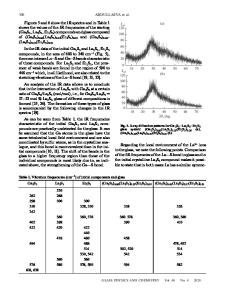Electrochemical Sulfur Treatments of GaAs Using Na 2 S and (NH 4 ) 2 S Solutions: A Surface Chemical Study
- PDF / 417,710 Bytes
- 6 Pages / 420.48 x 639 pts Page_size
- 28 Downloads / 335 Views
ELECTROCHEMICAL SULFUR TREATMENTS OF GaAs USING Na 2S AND (NI-4)2S SOLUTIONS: A SURFACE CHEMICAL STUDY J. YOTA AND V. A. BURROWS Department of Chemical, Bio, and Materials Engineering and Center for Solid State Electronics Research, Arizona State University, Tempe, Arizona 85287-6006 ABSTRACT Chemical sulfur treatments of GaAs have been shown to improve the GaAs surface electronic properties. These treatments result in lower surface state density, lower surface recombination velocity, and shifting or unpinning of the Fermi level, in addition to improvement in the performance of devices. However, there is still considerable controversy regarding the chemical nature of the surface film which results from this chemical sulfidation. It has been shown that this film is not stable chemically and electronically. The improved surface electronic properties decay with time and are sensitive to the chemical environment of the material. In this study, using surface infrared reflection spectroscopy (SIRS) and x-ray photoelectron spectroscopy (XPS), we have investigated the electrochemical sulfidation of GaAs as a possible new method to produce a GaAs surface that is stable chemically and electronically. We have found that anodic treatments with Na 2S and (NH 4 )2S solutions result in the removal of the pre-existing oxide of GaAs and the formation of films comprising sulfur, sodium carbonate, ammonium thiosulfate, and sulfide and sulfur-oxygen compounds of arsenic. Rinsing the GaAs with water removes the bulk of the film, leaving behind a surface on which only arsenic sulfide was detected. I. INTRODUCTION GaAs has long been known to have poor surface electronic properties. These properties include high surface state density, high surface recombination velocity, and Fermi level pinning. A promising method for improving these properties is by simple chemical treatments with sulfur solutions. These sulfidation treatments have been shown to result in low surface recombination velocity [1], low surface state density [2,3], and Fermi level unpinning or shifting [4-61, and in improvement in the performance of heterojunction bipolar transistors (HBTs) [7-81, p-n junction diodes [31, metal-insulator-semiconductor (MIS) structures [91, solar cells [6,101, and laser diodes [11,121. In spite of the improved electrical behavior caused by these treatments, not much is known of the chemical nature of the surface after treatments. Controversies still exist as to whether preexisting oxides remain after treatments [13,14], or whether they are completely removed [15-171. In addition, some studies report that the surface is terminated by both Ga-S and As-S bonds [13,16-181, while others have reported only Ga-S [14,191, or As-S [10,151 bonds after treatment. It has also been found that the film which results from these chemical treatments is not stable chemically and electronically. The improved surface electronic properties are found to decay with time and are sensitive to light, air, and temperature [1,3,14,18,20,211. Rinsing the treated GaAs surf
Data Loading...











